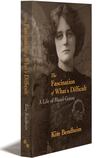
For the common Irish reader, the problem with Maud Gonne is that our images of her are already well established. There is Yeats’s troubling muse, who inspired some of the greatest poetry in the English language. Then there is the Joan of Arc of Irish nationalism, who never quite made it to the stake; and the monstre sacré of her later years, firing off letters to the newspapers and organising endless petitions, most memorably, if maliciously, captured in her son-in-law Francis Stuart’s strange masterpiece, Black List, Section H.
The great virtue of Kim Bendheim’s book is that she brings fresh perspectives – non-academic, contemporary and American – to bear on the known facts of Gonne’s life, and taken together they are revelatory.
Bendheim focuses on one aspect of Maud Gonne which literary historians are too polite to dwell upon: her great wealth. Her grandfather, Francis Cooke, is often referred to as a draper, but if he was a draper, then Arthur Guinness was a barman. When he died, Cooke was the third richest man in England. As a child, Maud would live with her baronet uncle in Doughty House in Richmond, where she played in the galleries he had built to house his collection of Durer, Rembrandt, Velazquez, Van Eyck and El Greco. Just last year the property was put on the market with a guide price of £100 million (¤116 million).
Truly, to those middle-class Dubliners and Anglo-Irish clinging to their last 1,000 acres who were her audience, Gonne must have cut a striking figure, and not just because of her height and beauty. No wonder she played down her background, claiming a dubious descent from dispossessed Mayo farmers.
This wealth was both a blessing and a curse. It meant she could be independent and live her life as she chose, in contrast to most women at the time. But this independent lifestyle would eventually cost her the support of Irish nationalists.
Why did she throw her great energies into the struggle for Irish independence? She claimed it was the evictions and poverty she witnessed in the Irish countryside that made her a nationalist, and she was always an activist for social issues, which led to her long friendship with James Connolly. Or perhaps, as she put it, “Life without a cause would be dull.”
In France, aged 20, she had met the married right-wing politician and journalist Lucien Millevoye, who would become her long-term lover and father of two of her children. Bendheim acutely points out that despite her high profile in Ireland, Paris was her permanent residence in those years – the obvious reason being that to live openly as a single woman with a well-known lover and an illegitimate child, Iseult, was permissible in Paris, whereas in London or Dublin it would be impossible.
Millefoye encouraged Gonne to think of herself as the Joan of Arc of Irish nationalism, the heroine in her own drama, on a much larger stage than the Abbey one Yeats would put her on in Cathleen ni Houlihan.
There is a dark side to the mystically tinged nationalism she and Millefoye embraced. When Bendheim, in her research, discovered the extent of Gonne’s anti-Semitism, most vehemently expressed during the Dreyfus affair, she was so shocked that she was tempted to abandon the biography altogether. However, I suspect that Gonne’s anti-Semitism, which she continued to express unashamedly throughout her long life, was as much a product of her upper-class British background as it was a political philosophy.
Soon after the break-up of her relationship with Millefoye, Gonne married Major John McBride, even though she had written that marriage, in her view, was an abomination. Everyone, including her close friend Arthur Griffith, advised her against marrying the future 1916 hero, immortalised by Yeats as “a drunken vainglorious lout”. Lady Gregory, steelily practical as ever, advised Gonne to marry in the British embassy in Paris so that McBride could not access her fortune under French law.
The marriage produced a son, Sean, but McBride’s misbehaviour and alleged sexual advances to Iseult soon brought the marriage to an end. Gonne packed him off back to Dublin and sued for divorce, which finally put her outside the pale for Irish nationalists.
With the birth of the new State, the 1916 widow returned to Dublin but was hardly welcomed with open arms. The top-hatted, Mass-going men who had taken power moved quickly to sideline those independent Protestant women such as Gonne, Countess Markievicz, Kathleen Lynn and her partner Madeleine ffrench-Mullen, who had fought so steadfastly in the War of Independence and continued to fight for social justice and equality for women.
Bendheim’s book does not cancel out the images we have of Maud Gonne, but certainly adds to them, giving us a broader picture of this undoubtedly difficult and fascinating woman.
Michael O’Loughlin’s most recent book is Liberty Hall (New Island)










